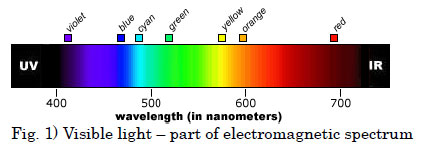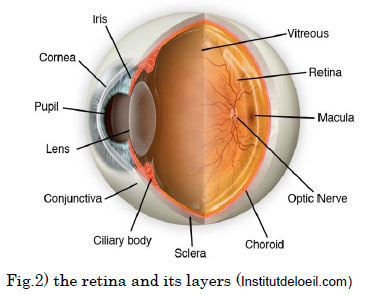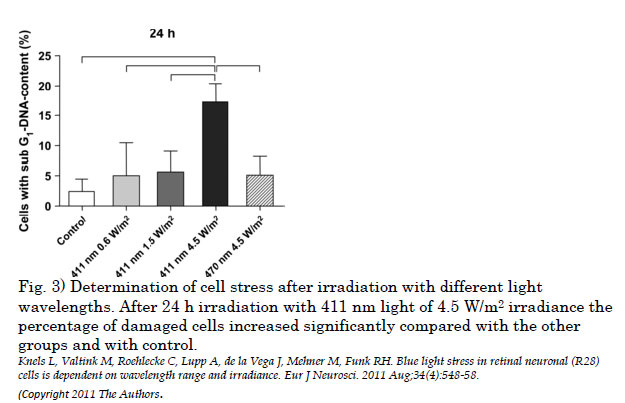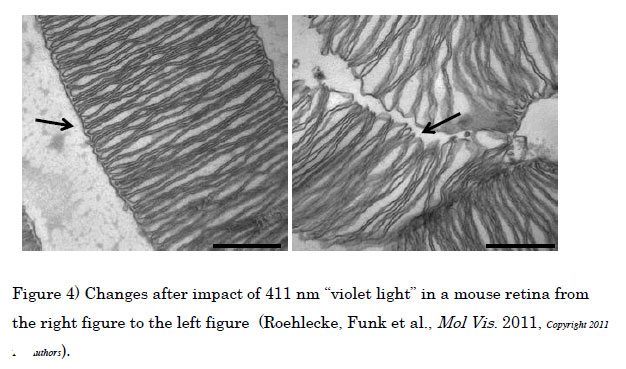Regardless of weather, sunny or cloudy, our eyes are constantly damaged by sunlight. It is well-known that our eyes should be protected from damage by ultraviolet (UV) rays, which are one part of the shorter wavelength light in sunlight in Fig. 1). Because the shorter wavelength light of 400nm-420nm, which we call high energy violet (HEV) light, possesses much more energy than longer wavelengths (red end of the spectrum), it can also elicit more physiochemical reactions within the eye.

Through the cornea or the eye lens (see Fig.2), HEV light is harmfully transmitted onto the retina, which is the most delicate and vulnerable tissue of the eye. Especially, HEV light is more harmful for younger individuals up to about 20 years old, who play and enjoy outside under sunlight, because their eye lenses are very transparent. People after cataract surgery and with implantation of colorless plastic lenses can also be injured by the harmful light coming through their clear, artificial lens.

According to recent studies, it was shown that HEV light can cause oxidative stress within different layers of the retina (see Fig.2). The group of Funk (2011a) showed in standardized laboratory experiments that neuronal retinal cells after exposure to short wavelength light of 411nm begins to die from higher stress than after exposure to 470nm light. (Fig.3). Furthermore, the Funk (2011b) group demonstrated that after exposure to 411nm light the retina gets distorted (Fig. 4).


These events can also happen in the human retina as one of the factors which accelerates the development of Age-related Macular Degeneration (AMD) (Wu et al. 2006, Jarett and Boulton 2012). Also, HEV light can alter the eye lens in its composition, which can lead to cataract formation via radicals and oxidative stress (Roberts 2011).
Thus, it is very useful to block HEV light of 400nm – 420 nm, because the light can trigger harmful processes for the eye. On the other hand, this blocking does not significantly affect the natural impression of our color vision. Also, the morning light of 488nm (Bailes and Lucas 2013) is not impeded for the wakening effect, to maintain our circadian rhythm.
References
- Bailes HJ, Lucas RJ. Human melanopsin forms a pigment maximally sensitive to blue light (λmax ≈ 479 nm) supporting activation of G(q/11) and G(i/o) signalling cascades. Proc Biol Sci. 2013 Apr 3;280(1759):20122987.
- Jarrett, S.G.; Boulton, M.E. Consequences of oxidative stress in age-related macular degeneration. Mol Aspects Med 2012, 33, 399-417
- Knels L, Valtink M, Roehlecke C, Lupp A, de la Vega J, Mehner M, Funk RH. Blue light stress in retinal neuronal (R28) cells is dependent on wavelength range and irradiance. Eur J Neurosci. 2011 Aug;34(4):548-58
- Roberts JE. Ultraviolet radiation as a risk factor for cataract and macular degeneration. Eye Contact Lens. 2011 Jul;37(4):246-9
- Roehlecke C, Schumann U, Ader M, Brunssen C, Bramke S, Morawietz H, Funk RH. Stress reaction in outer segments of photoreceptors after blue light irradiation. PLoS One. 2013 Sep 11;8(9)
- Roehlecke C, Schumann U, Ader M, Knels L, Funk RH. Influence of blue light on photoreceptors in a live retinal explant system. Mol Vis. 2011 Apr 8;17:876-84
- Wu, J.; Seregard, S.; Algvere, P.V. Photochemical damage of the retina. Surv Ophthalmol 2006, 51, 461-481.
